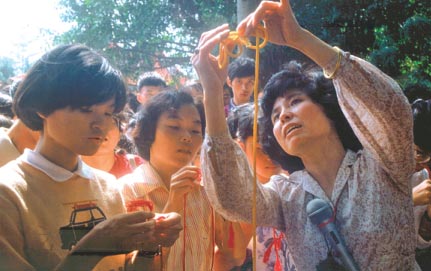Master of arts and guardian of crafts
By Peng Yining ( China Daily ) Updated: 2016-03-12 10:11:32
 |
|
A woman teaches how to make Chinese knot. [Photo provided to China Daily] |
Huang, born in Taoyuan, Taiwan, studied sculpture in one of the island's best art schools. Although it was in urban settings that he was mostly educated, his strongest recollections are of the countryside, he says.
"When I was a child, my home village was full of folk craft arts: the colorful costumes in folk operas, wall paintings in temples and traditional paintings for celebrating the Chinese New Year."
One of his strongest memories, he says, is of a ceremony worshipping Mazu, a goddess said to protect seafarers who is widely worshipped in Taiwan.
"Folk culture was once the glue of rural society, but it is now disappearing," Huang says. "I hope my magazine can be a kind of gene bank. Even if art forms die out, at least through the magazine people can relive them."
In his quest to collect folk craft, Huang travels frequently between Taiwan and the mainland. The mainland has a longer tradition of craft making and is better endowed with resources, he says. In his first visit to Beijing he was particularly impressed by homemade red lanterns for celebrating the Chinese New Year.
"Craft arts were everywhere in the mainland, and people were still making and using them. I was thrilled. It was as if I had discovered a gold mine. But with the rapid urbanization of the past few decades those traditions have been disappearing at an unprecedented rate."
While Huang has been privileged to watch on as crafts that seemed on the verge of distinction have shown new spurts of life, he has also been a front-row spectator as some have died. Twenty years ago, he says, he visited a craftsman who was using methods dating to the Tang Dynasty (618-907) to dye fabrics.
"He was breaking his old dye vat into pieces. When I asked if he was about to buy a bigger vat he said hardly anyone bought his stuff and he was about to quit. He was the last person I know who still knew how to dye textiles in the Tang Dynasty fashion, and his quitting meant that that skill was about to die."
Even with the coverage that Han Sheng gave to those skills, it was not enough to save the craft, he says, and the workshop of that old craftsman is now a mere relic, albeit a tourist spot where people can buy traditional textiles, and see the tools of the old trade.
- China's Longmen Grottoes opens new Buddhist cave
- New Year paintings decorate cottage walls in spring
- Palace Museum director proposes to expand the capital’s historical and cultural protection area
- New discoveries in Phoenix Mountain kiln site in Zhejiang
- Ceremony held to welcome 'Wang Gong' in SW China
|
|
|
|
|
|
|
|

























 Raymond Zhou:
Raymond Zhou: Pauline D Loh:
Pauline D Loh: Hot Pot
Hot Pot Eco China
Eco China China Dream
China Dream China Face
China Face






